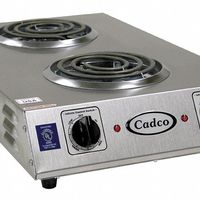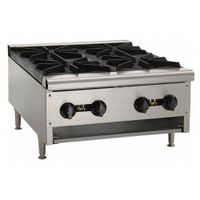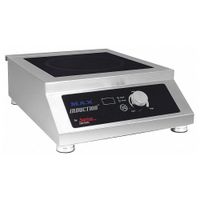Call +(254) 703 030 000 / 751 483 999 / 721 704 777
- Home
- Furnishings Appliances Hospitality
- Appliances
- Countertop Ranges Hot Plates
Frequently Asked Questions
What is the difference between gas, electric, and induction countertop ranges?
Gas, electric, and induction countertop ranges differ primarily in their energy sources and heating methods.
Gas ranges use natural gas or propane as fuel. They provide instant heat and precise temperature control, making them popular among chefs. The flame is visible, allowing for intuitive adjustments. However, they require proper ventilation and can be less energy-efficient due to heat loss around the cookware.
Electric ranges use electricity to heat coils or a smooth ceramic-glass surface. They are generally easier to clean and maintain, especially the smooth-top models. Electric ranges offer consistent heat but can be slower to adjust temperatures compared to gas. They are more energy-efficient than gas but less so than induction.
Induction ranges also use electricity but operate differently. They generate a magnetic field that directly heats the cookware, not the cooktop. This method is highly energy-efficient and provides rapid heating and precise control. Induction ranges remain cool to the touch, reducing burn risks. However, they require compatible cookware, typically ferrous metal like cast iron or some stainless steels.
In summary, gas ranges offer quick, visible heat and control but need ventilation. Electric ranges are easy to clean and provide steady heat but are slower to adjust. Induction ranges are the most energy-efficient, with fast, precise heating, but require specific cookware.
How do induction ranges work?
Induction ranges work by using electromagnetic fields to directly heat pots and pans. Unlike traditional gas or electric stoves, which heat indirectly by warming the air or a heating element, induction cooktops use copper coils beneath a glass-ceramic surface to generate a magnetic field. When a ferromagnetic cookware, such as cast iron or some stainless steels, is placed on the cooktop, the magnetic field induces electric currents in the metal. These currents, known as eddy currents, generate heat due to the resistance of the metal, effectively turning the cookware itself into the heating element.
The process is highly efficient because energy is transferred directly to the cookware, minimizing heat loss. This results in faster cooking times and more precise temperature control. The cooktop surface remains relatively cool, as it only heats up from contact with the hot cookware, reducing the risk of burns and making it easier to clean spills.
Induction ranges require compatible cookware, typically those with a flat bottom and magnetic properties. Non-magnetic materials like aluminum, copper, or glass will not work unless they have a magnetic layer added to the base.
The control system of an induction range allows for rapid adjustments in heat levels, providing precise cooking control. Safety features often include automatic shut-off if no cookware is detected and child locks to prevent accidental activation.
Overall, induction ranges offer energy efficiency, speed, safety, and ease of cleaning, making them a popular choice in modern kitchens.
Are gas countertop ranges more efficient than electric ones?
Gas countertop ranges are generally considered less energy-efficient than electric ones. Gas ranges convert about 40-60% of their energy into cooking heat, while electric ranges, particularly those with induction technology, can convert about 70-90% of their energy. This means electric ranges typically use less energy to achieve the same cooking results.
However, efficiency can also be evaluated in terms of cooking speed and control. Gas ranges offer immediate heat and precise temperature control, which can lead to faster cooking times and potentially less energy use in specific scenarios. Electric ranges, especially induction, heat up quickly and provide consistent heat, but traditional electric coils may take longer to adjust temperatures.
Cost is another factor. Natural gas is often cheaper than electricity, which can make gas ranges more cost-effective in terms of operational expenses, despite their lower energy efficiency. However, this can vary based on local utility rates.
Environmental impact is also a consideration. Electric ranges can be more environmentally friendly if the electricity comes from renewable sources, whereas gas ranges rely on fossil fuels, contributing to greenhouse gas emissions.
In summary, while electric ranges are generally more energy-efficient, gas ranges offer advantages in terms of cooking speed and control. The choice between the two may depend on personal cooking preferences, cost considerations, and environmental concerns.
What are the benefits of using an induction range?
Induction ranges offer several benefits that make them an attractive choice for modern kitchens. Firstly, they provide rapid heating and precise temperature control. Induction cooktops use electromagnetic fields to directly heat pots and pans, allowing for faster cooking times and immediate adjustments in temperature. This efficiency not only saves time but also energy, as less heat is wasted compared to traditional gas or electric stoves.
Safety is another significant advantage. Induction cooktops remain cool to the touch, reducing the risk of burns. The heat is generated only when a compatible pot or pan is placed on the surface, minimizing the chance of accidental fires. Additionally, many induction ranges come with safety features like automatic shut-off and child locks.
Induction ranges are also easy to clean. Since the cooktop itself doesn’t get hot, spills and splatters are less likely to burn onto the surface, making cleanup quick and straightforward. The smooth, flat surface of induction cooktops further simplifies maintenance.
Moreover, induction cooking is environmentally friendly. It is more energy-efficient than gas or traditional electric cooking methods, as it uses less energy to achieve the same results. This efficiency can lead to lower utility bills and a reduced carbon footprint.
Finally, induction ranges offer a sleek, modern aesthetic that can enhance the look of any kitchen. Their minimalist design and advanced technology appeal to those seeking both functionality and style in their kitchen appliances. Overall, the benefits of using an induction range include speed, safety, efficiency, ease of cleaning, and aesthetic appeal, making it a compelling choice for many home cooks.
Do electric hot plates consume a lot of electricity?
Electric hot plates generally do not consume a lot of electricity compared to larger kitchen appliances, but their consumption can vary based on several factors. The power consumption of an electric hot plate is typically measured in watts, with most models ranging from 750 to 1,500 watts. The actual electricity usage depends on the wattage of the hot plate and the duration of use.
For example, a 1,000-watt hot plate used for one hour will consume 1 kilowatt-hour (kWh) of electricity. If your electricity rate is $0.12 per kWh, this would cost you $0.12 for that hour of use. In comparison, larger appliances like ovens or stoves can consume significantly more power, often ranging from 2,000 to 5,000 watts.
The efficiency of the hot plate also plays a role in its electricity consumption. Induction hot plates are generally more energy-efficient than traditional electric coil or infrared models because they directly heat the cookware, reducing energy loss. Additionally, the size of the cookware and the cooking method can impact energy usage. Using a lid on pots and pans can help retain heat and reduce cooking time, thereby saving electricity.
In summary, while electric hot plates do consume electricity, they are relatively efficient for small-scale cooking tasks. Their consumption is moderate compared to larger kitchen appliances, making them a cost-effective option for quick meals or as a supplementary cooking device.
How do I install a gas countertop range?
1. **Check Local Codes**: Ensure compliance with local building codes and regulations for gas appliances.
2. **Gather Tools and Materials**: You’ll need a wrench, screwdriver, gas line, gas shut-off valve, pipe sealant, and possibly a new countertop cutout template.
3. **Turn Off Gas Supply**: Shut off the main gas supply to your home to ensure safety.
4. **Prepare the Countertop**: If replacing an old range, remove it. If installing a new one, ensure the countertop cutout matches the range’s specifications.
5. **Install Gas Shut-off Valve**: Attach a shut-off valve to the gas supply line if not already present. Use pipe sealant on threaded connections to prevent leaks.
6. **Position the Range**: Carefully place the range into the countertop cutout, ensuring it fits snugly and is level.
7. **Connect Gas Line**: Attach the gas line to the range’s inlet. Use a flexible gas connector for ease and apply pipe sealant to threaded connections.
8. **Secure the Range**: Fasten the range to the countertop using brackets or screws as per the manufacturer’s instructions.
9. **Check for Leaks**: Turn on the gas supply and use a gas leak detector or soapy water to check connections for leaks. Bubbles indicate a leak that must be fixed before proceeding.
10. **Test the Range**: Ignite the burners to ensure they function correctly. Adjust flame settings as needed.
11. **Final Adjustments**: Ensure the range is level and secure. Make any necessary adjustments to the countertop or range position.
12. **Clean Up**: Remove any debris and ensure the area is clean and safe.
13. **Consult a Professional**: If unsure at any step, consult a licensed professional to ensure safety and compliance.
Can I use any type of cookware on an induction range?
No, you cannot use any type of cookware on an induction range. Induction cooktops require cookware made of ferromagnetic material, meaning the cookware must have a magnetic base to work effectively. This is because induction cooking uses electromagnetic fields to generate heat directly in the cookware, rather than heating the cooktop surface itself.
Suitable cookware for induction ranges includes:
1. **Cast Iron**: Naturally magnetic and works well with induction cooktops. It retains heat efficiently but can be heavy and may scratch the cooktop surface if not handled carefully.
2. **Stainless Steel**: Not all stainless steel is magnetic, so it's important to check if the base is compatible. Some stainless steel cookware has a magnetic layer added to the base to make it induction-friendly.
3. **Carbon Steel**: Similar to cast iron, carbon steel is magnetic and works well on induction ranges. It is lighter than cast iron and heats up quickly.
4. **Enameled Cast Iron**: This type of cookware is also suitable for induction cooking, as long as the base is magnetic.
Cookware that is generally not suitable for induction ranges includes:
1. **Aluminum**: Unless it has a magnetic base, aluminum cookware will not work on induction cooktops.
2. **Copper**: Like aluminum, copper is not magnetic and requires a magnetic base to be used on induction ranges.
3. **Glass and Ceramic**: These materials are not magnetic and cannot be used on induction cooktops.
To test if your cookware is compatible, you can use a simple magnet. If the magnet sticks to the bottom of the cookware, it is likely suitable for induction cooking.


